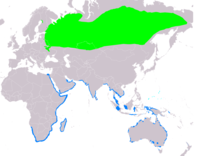Terek sandpiper
| Terek sandpiper | |
|---|---|

| |
| Scientific classification | |
| Domain: | Eukaryota |
| Kingdom: | Animalia |
| Phylum: | Chordata |
| Class: | Aves |
| Order: | Charadriiformes |
| Family: | Scolopacidae |
| Genus: | Xenus Kaup, 1829 |
| Species: | X. cinereus
|
| Binomial name | |
| Xenus cinereus (Güldenstädt, 1775)
| |

| |
| Range of X. cinereus (Compiled by: BirdLife International and Handbook of the Birds of the World (2019) 2019) Breeding Passage Non-breeding
| |
| Synonyms | |
|
Tringa cinerea | |
The Terek sandpiper (Xenus cinereus) is a small
Taxonomy
The Terek sandpiper was
Among the
Description

Slightly larger than the common sandpiper at 22–25 cm (8.7–9.8 in) length, its long upcurved bill – somewhat reminiscent of an avocet's, but not as strongly curved – makes it very distinctive. As the scientific specific name implies, this wader has a grey back, face and breast in all plumages; a white supercilium may appear more or less distinct. The belly is whitish and the feet yellow; the bill has a yellowish base, with the rest being black.
The call is a high whistle.
Distribution and ecology
This bird breeds near water in the
The overall genetic variation in Terek sandpipers across their range is low, with some evidence of contractions followed by expansion. Although the geographically isolated Dniephe River population in Eastern Europe does show significant genetic differentiation.[12]
It feeds in a distinctive and very active way, chasing insects and other mobile prey, and sometimes then running to the water's edge to wash its catch.
It lays three or four eggs in a lined ground scrape.
The Terek sandpiper likes to associate with
This is one of the species to which the Agreement on the Conservation of African-Eurasian Migratory Waterbirds (
Gallery
-
Terek sandpiper Xenus cinereus, little stint Calidris minuta and marsh sandpiper Tringa stagnatilis in Krishna Wildlife Sanctuary, Andhra Pradesh, India.
-
Eating ragworm in Shōnai River, Japan.
-
Egg, Collection Museum Wiesbaden
-
In flight
References
- . Retrieved 11 November 2021.
- ^ Güldenstädt, Johann Anton (1775). Novi Commentarii academiae scientiarium imperialis Petropolitanae (in Latin). Vol. 19. p. 473–475, Plate 19.
- ^ Kaup, Johann Jakob (1829). Skizzirte Entwickelungs-Geschichte und natürliches System der europäischen Thierwelt (in German). Vol. c. 1. Darmstadt: Carl Wilhelm Leske. p. 115.
- ^ Rasmussen, Pamela, eds. (July 2021). "Sandpipers, snipes, coursers". IOC World Bird List Version 11.2. International Ornithologists' Union. Retrieved 10 December 2021.
- ISBN 978-1-4081-2501-4.
- OCLC 156629447.
- PMID 13678682.
- PMID 15329156.
- ^ Wiles, Gary J.; Johnson, Nathan C.; de Cruz, Justine B.; Dutson, Guy; Camacho, Vicente A.; Kepler, Angela Kay; Vice, Daniel S.; Garrett, Kimball L.; Kessler, Curt C.; Pratt, H. Douglas (2004). "New and Noteworthy Bird Records for Micronesia, 1986–2003". Micronesica. 37 (1): 69–96.
- ^ VanderWerf, Eric A.; Wiles, Gary J.; Marshall, Ann P.; Knecht, Melia (2006). "Observations of migrants and other birds in Palau, April–May 2005, including the first Micronesian record of a Richard's Pipit" (PDF). Micronesica. 39 (1): 11–29.
- ^ a b White, Richard W.; Lehnhausen, Bud; Kirwan, Guy M. (2006). "The first documented record of Terek Sandpiper Xenus cinereus for Brazil". Revista Brasileira de Ornitologia (in English and Portuguese). 14 (4): 460–462.
- S2CID 92795013.
- ^ "Species factsheet: Xenus cinereus". www.birdlife.org. BirdLife International. 2008.
External links
- Terek sandpiper species text in The Atlas of Southern African Birds
- "Xenus cinereus". Avibase.
- "Terek sandpiper media". Internet Bird Collection.
- Terek sandpiper photo gallery at VIREO (Drexel University)
- Interactive range map of Xenus cinereus at IUCN Red List maps
- Audio recordings of Terek sandpiper on Xeno-canto.
- Xenus cinereus in Field Guide: Birds of the World on Flickr
- Terek sandpiper media from ARKive







